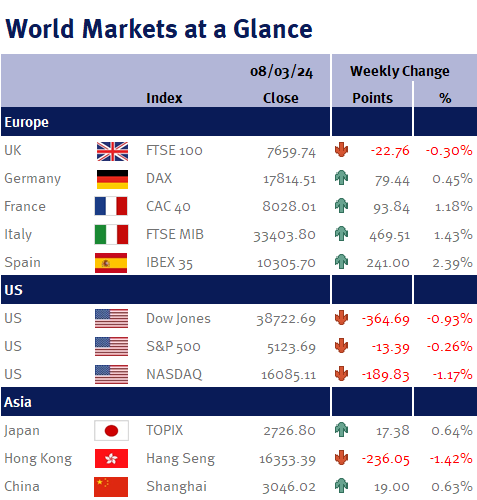Also in the US, February’s labour market data revealed stronger-than-expected job creation, however, there was an unexpected uptick in the unemployment rate from 3.7% to 3.9%. Wages increased by 0.1% monthly and 4.3% annually, slightly below economist expectations, a positive sign for inflation. Powell characterised the labour market as “relatively tight” during his Capitol Hill testimony. Whilst the data was mixed, a trend is emerging that aligns the Federal Reserve’s preferences for some softening in the labour market and lower wage growth to alleviate inflationary pressures.
Markets, anticipating a potential US interest rate cut in June, priced in three to four rate cuts for the year. The upcoming Consumer Price Index report is awaited to determine if the trend of slightly hotter-than-expected inflation extended into February, following January’s annual rate of 3.1%.
China reported a robust trade surplus this week for the first two months of 2024, with exports surging 7.1% on-year, surpassing the 1.9% forecast. Policymakers prefer to examine the combined data for January and February to mitigate the Lunar New Year effect on the results. Data later in the week also revealed China’s consumer prices rose by 0.7% year on year in February, firmly above forecasts of 0.3% thanks to robust spending during the Lunar New Year holiday. Chinese equities gained as the People’s Bank of China’s recent market stabilisation measures lifted investor confidence despite an uncertain economic outlook.
The European Central Bank (ECB) maintained interest rates at 4.0% as expected, but recognised progress in reducing inflation. ECB President Christine Lagarde hinted at a potential rate cut in June, contingent on further data, especially regarding wages. Lagarde noted an anticipated shift in inflation to 2.0% by 2025, deviating from the previous forecast of 2026.
Coming up next week, UK unemployment rate and wage data. Also in the UK, GDP for January and industrial production. US CPI, PPI and retail sales. US industrial production and University of Michigan consumer sentiment.
Kate Mimnagh, Portfolio Economist



